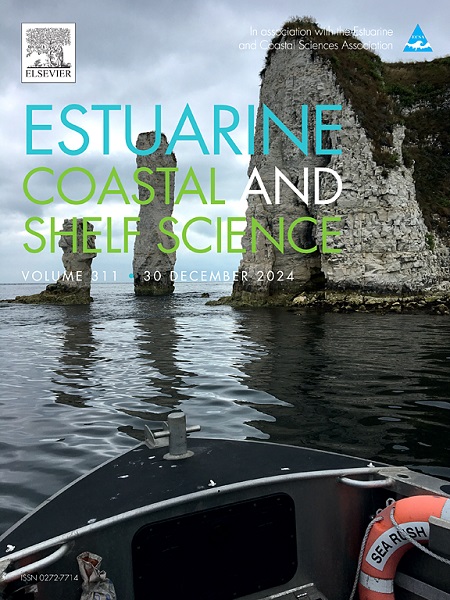绘制未知的地图:巴西大陆边缘大范围底栖动物栖息地分布
IF 2.6
3区 地球科学
Q1 MARINE & FRESHWATER BIOLOGY
引用次数: 0
摘要
了解底栖生物栖息地的分布对采取管理措施保护环境免受日益增长的人类活动的影响具有关键意义。在世界各地的一些倡议下,广泛的栖息地测绘已经发展起来,主要依赖于对解释不同底栖动物组成至关重要的环境属性的测绘。这种方法通常依赖于提供共同语言和栖息地描述的栖息地分类方案。应用最广泛的分类方案之一是欧洲联盟自然信息系统(EUNIS),该系统已用于不同的大比例尺制图项目。在本文中,我们应用EUNIS方法绘制了巴西边缘底栖生物栖息地的分布图,并将其划分为巴西北部大陆架(NBS)、热带西南大西洋(TSA)和暖温带西南大西洋(WTSA)三个生态区省。我们编制了GIS层的环境参数,包括(i)水深测量;(ii)基材类型;(iii)透光区深度;(iv)波底深度及;(v)地貌特征。绘制了覆盖巴西边缘580万平方公里的地图,其中大部分被归类为深海泥(34.03%)。陆架生境主要为近海环海泥质(2.75%)、滨海下砂质(1.83%)和环海泥质(1.77%)。与环海(415平方公里)和近海环海(9840平方公里)相比,生物栖息地高度集中在沿海地带(29,579平方公里)。本研究的结果对管理目的具有重要意义,特别是对支持巴西正在进行的海洋空间规划工作具有重要意义。了解底栖生物栖息地的广泛分布关系到在这一过程中产生的不同信息层,例如确定保护价值、对人类压力的敏感性和提供生态系统服务。本文章由计算机程序翻译,如有差异,请以英文原文为准。
Charting the uncharted: Broad-scale benthic habitat distribution in the Brazilian continental margin
Understanding the distribution of benthic habitats is of key relevance to inform management measures to protect this environment from ever growing human activities. Broad-scale habitat mapping has been developed under several initiatives around the world, mostly relying on the mapping environmental attributes that are vital to explain different benthic fauna composition. This approach usually depends on a habitat classification scheme that provides a common language and description of habitats. One of the most widely applied classification schemes is the European Union Nature Information System (EUNIS), which has been used under different broad-scale mapping projects. In this article, we applied the EUNIS approach to map the distribution of benthic habitats in the Brazilian margin, segmented on the three ecoregion provinces that occur within the country marine waters: North Brazil Shelf (NBS), Tropical Southwestern Atlantic (TSA) and Warm Temperate Southwestern Atlantic (WTSA). We compiled GIS layers of environmental parameters, including (i) bathymetry; (ii) substrate type; (iii) depth of euphotic zone; (iv) depth of wave base and; (v) geomorphic features. A map covering 5,800,000 km2 of the Brazilian margin was produced, most of which were classified as abyssal mud (34.03%). Shelf habitats were mainly classified as offshore circalittoral mud (2.75%), infralittoral sand (1.83%) and circalittoral mud (1.77%). Biogenic habitats are highly concentrated in the infralittoral zone (29,579 km2) compared to the area mapped in the circalittoral (415 km2) and offshore circalittoral (9840 km2). The results presented in this research are of major relevance for management purposes, especially for supporting the ongoing Marine Spatial Planning endeavor in Brazil. Understanding the broad distribution of benthic habitats is relevant for different information layers to be produced under this process, such as the identification of values for conservation, sensitivity to human pressures and provision of ecosystem services.
求助全文
通过发布文献求助,成功后即可免费获取论文全文。
去求助
来源期刊
CiteScore
5.60
自引率
7.10%
发文量
374
审稿时长
9 months
期刊介绍:
Estuarine, Coastal and Shelf Science is an international multidisciplinary journal devoted to the analysis of saline water phenomena ranging from the outer edge of the continental shelf to the upper limits of the tidal zone. The journal provides a unique forum, unifying the multidisciplinary approaches to the study of the oceanography of estuaries, coastal zones, and continental shelf seas. It features original research papers, review papers and short communications treating such disciplines as zoology, botany, geology, sedimentology, physical oceanography.

 求助内容:
求助内容: 应助结果提醒方式:
应助结果提醒方式:


